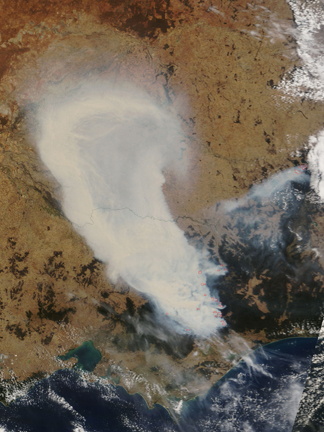|
Web Extra Tuesday, December 12, 2006
Small nuclear war could pose large climate consequences
SAN FRANCISCO - The Cold War has been over for nearly two decades,
but the threat of a nuclear winter still looms. Even relatively small,
regional nuclear conflicts could produce widespread fires large enough
to reach into the upper atmosphere and induce a decade of global climate
cooling, according to new research presented Monday at the American
Geophysical Union's (AGU) fall meeting in San Francisco. The findings
suggest that climatic effects from even a small-scale nuclear war between
states such as India and Pakistan could match the climate impact once
predicted for an all-out attack by a superpower.
Nuclear proliferation peaked in 1986, and worldwide stockpiles of weapons
began to decrease sharply as the Soviet Union disintegrated and superpowers
disarmed. But although the total global arsenal is now only a third of
its peak size, 40 countries now possess the materials to make nuclear
weapons, Brian Toon, an atmospheric scientist at the University of Colorado
at Boulder, said at the AGU meeting. The combination of such new, often
politically unstable nuclear powers and the increasing number of "megacities"
with high population densities has now put the planet "at a perilous
crossroads," Toon said.
A plume of smoke more than 250
kilometers wide — caused by bushfires in the Great Dividing Range
Mountains — flowed across the Victoria-New South Wales border in
Australia on Dec. 12. Such fires rarely reach the stratosphere. Smoke
from fires caused by even a small-scale nuclear war could reach the stratosphere,
however, with potentially devastating climate effects worldwide, according
to research presented Monday at the fall meeting of the American Geophysical
Union. Image is courtesy of the MODIS Rapid Response Team, NASA Goddard
Space Flight Center.
Toon's study, which he said is the "first comprehensive quantitative
study of consequences between smaller nuclear states," presents new
atmospheric models that predict what would happen to the global climate
if 50 15-kiloton weapons — equivalent to the total arsenal of India
and Pakistan — were detonated.
Although scientists conducted similar studies in the 1980s to determine
the potential dangers of nuclear conflict on climate, they lacked the
high-resolution models available today, said Alan Robock, an atmospheric
scientist at Rutgers University, who worked with Toon and is lead author
on a related study also presented at the AGU meeting. "The goal of
the study was to see whether we could still produce a nuclear winter with
the current arsenal," said Robock, who, along with Toon, produced
some of the first models of potential nuclear effects on climate in the
early 1980s.
The new models incorporate a factor that was largely unforeseen two decades
ago: Nuclear weapons not only produce deadly radiation, but can also ignite
massive fires on a scale rarely seen on Earth, with far-reaching atmospheric
impacts.
"A nuclear weapon is very unique in starting fires," said Richard
Turco, an atmospheric scientist at the University of California at Los
Angeles, who was a co-author on Toon's paper and also helped shape the
early 1980s modeling of nuclear winter. "It's a release of intense
radiation that has the same spectral characteristics of sunlight. It's
like bringing a piece of the sun to Earth." That "piece of sun"
can ignite as much as 10 to 15 square kilometers, he said.
Large wildfires inject smoke, largely composed of black carbon, into the
upper troposphere, where it is ultimately rained out. However, the models
suggest that if enough fires ignited at once — such as a giant fireball
produced by a nuclear explosion — their smoke would form a massive
cumulous cloud in the troposphere. When warmed by the sun, the cloud could
induce large-scale circulation that could lob it even higher into the
stratosphere, Toon said. Once in the stratosphere, the smoke would not
be rained out, but could persist far longer and travel around the globe.
Although rare, such "lofting" has been observed in nature with
forest fires, Toon said. The Chisholm fire, a massive wildfire that raged
in Alberta, Canada, in May 2001, created a massive fire plume, called
a "pyro-cumulonimbus," that released five kilotons of smoke
and produced enough energy to send it soaring into the stratosphere, said
Michael Fromm, a meteorologist at the U.S. Naval Research Laboratory.
The ultimate effect of catapulting so much smoke into the stratosphere
would be to reduce the amount of sunlight reaching Earth, thus cooling
surface temperatures by several degrees Celsius over large areas of North
America and Eurasia, reducing the average global growing season and reducing
precipitation by 10 percent of the current global average, Robock said.
Although such effects would change the ultimate profile of the controversial
"hockey stick" climate predictions, Robock said, "it's
not a solution to global warming."
Carolyn Gramling
Links:
AGU
annual meeting
Back to top

 Subscribe
Subscribe

